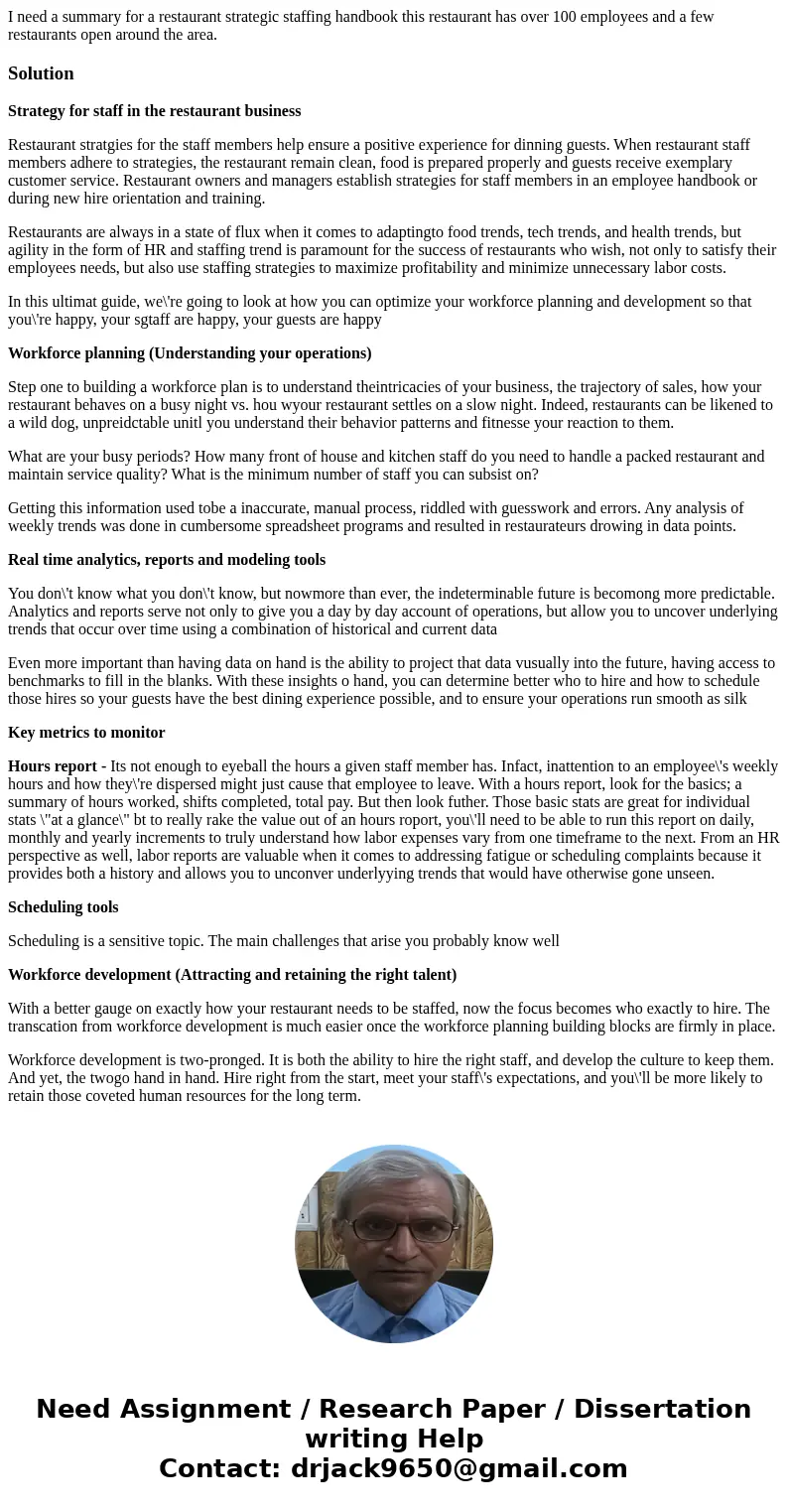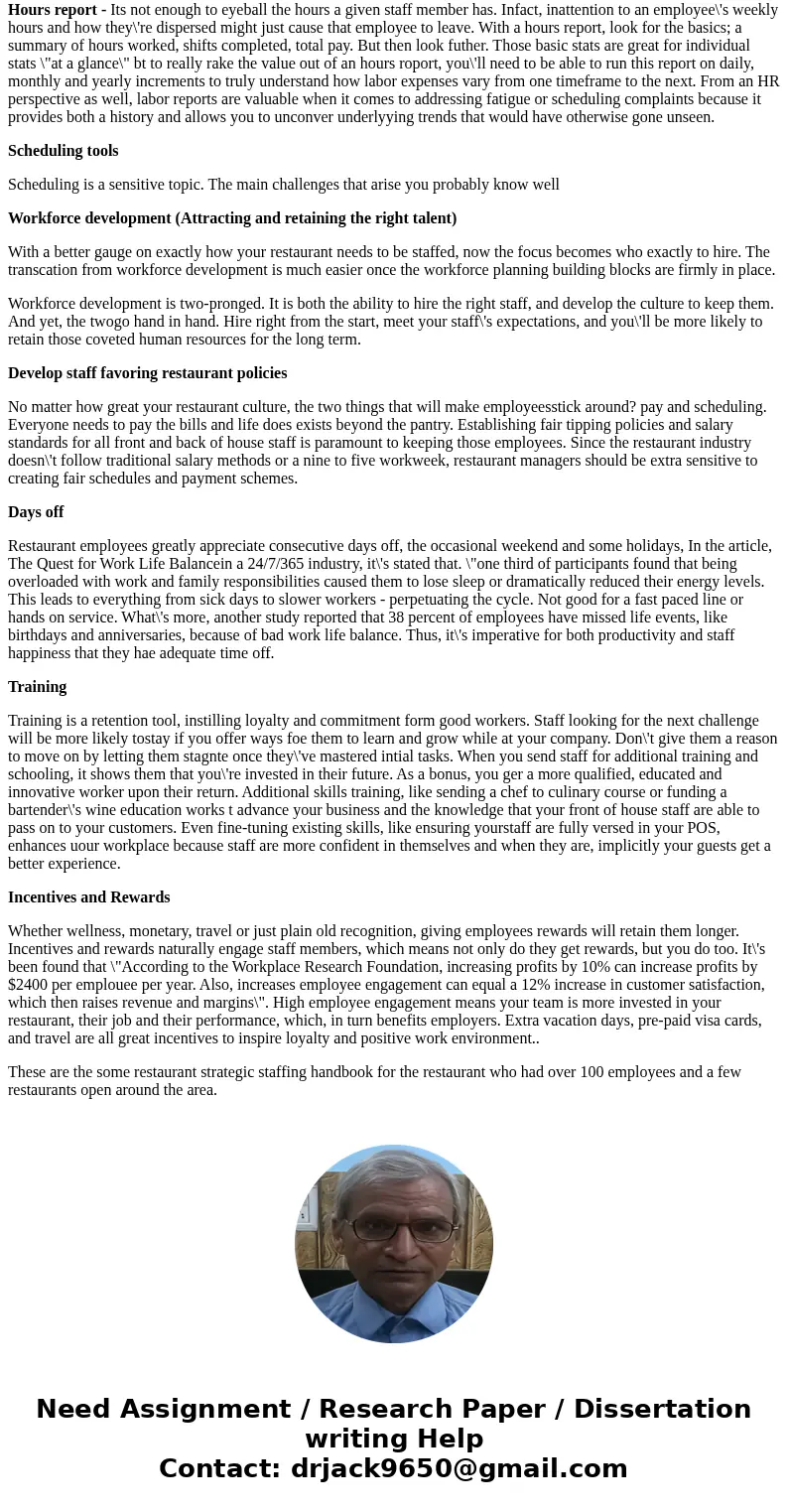I need a summary for a restaurant strategic staffing handboo
I need a summary for a restaurant strategic staffing handbook this restaurant has over 100 employees and a few restaurants open around the area.
Solution
Strategy for staff in the restaurant business
Restaurant stratgies for the staff members help ensure a positive experience for dinning guests. When restaurant staff members adhere to strategies, the restaurant remain clean, food is prepared properly and guests receive exemplary customer service. Restaurant owners and managers establish strategies for staff members in an employee handbook or during new hire orientation and training.
Restaurants are always in a state of flux when it comes to adaptingto food trends, tech trends, and health trends, but agility in the form of HR and staffing trend is paramount for the success of restaurants who wish, not only to satisfy their employees needs, but also use staffing strategies to maximize profitability and minimize unnecessary labor costs.
In this ultimat guide, we\'re going to look at how you can optimize your workforce planning and development so that you\'re happy, your sgtaff are happy, your guests are happy
Workforce planning (Understanding your operations)
Step one to building a workforce plan is to understand theintricacies of your business, the trajectory of sales, how your restaurant behaves on a busy night vs. hou wyour restaurant settles on a slow night. Indeed, restaurants can be likened to a wild dog, unpreidctable unitl you understand their behavior patterns and fitnesse your reaction to them.
What are your busy periods? How many front of house and kitchen staff do you need to handle a packed restaurant and maintain service quality? What is the minimum number of staff you can subsist on?
Getting this information used tobe a inaccurate, manual process, riddled with guesswork and errors. Any analysis of weekly trends was done in cumbersome spreadsheet programs and resulted in restaurateurs drowing in data points.
Real time analytics, reports and modeling tools
You don\'t know what you don\'t know, but nowmore than ever, the indeterminable future is becomong more predictable. Analytics and reports serve not only to give you a day by day account of operations, but allow you to uncover underlying trends that occur over time using a combination of historical and current data
Even more important than having data on hand is the ability to project that data vusually into the future, having access to benchmarks to fill in the blanks. With these insights o hand, you can determine better who to hire and how to schedule those hires so your guests have the best dining experience possible, and to ensure your operations run smooth as silk
Key metrics to monitor
Hours report - Its not enough to eyeball the hours a given staff member has. Infact, inattention to an employee\'s weekly hours and how they\'re dispersed might just cause that employee to leave. With a hours report, look for the basics; a summary of hours worked, shifts completed, total pay. But then look futher. Those basic stats are great for individual stats \"at a glance\" bt to really rake the value out of an hours roport, you\'ll need to be able to run this report on daily, monthly and yearly increments to truly understand how labor expenses vary from one timeframe to the next. From an HR perspective as well, labor reports are valuable when it comes to addressing fatigue or scheduling complaints because it provides both a history and allows you to unconver underlyying trends that would have otherwise gone unseen.
Scheduling tools
Scheduling is a sensitive topic. The main challenges that arise you probably know well
Workforce development (Attracting and retaining the right talent)
With a better gauge on exactly how your restaurant needs to be staffed, now the focus becomes who exactly to hire. The transcation from workforce development is much easier once the workforce planning building blocks are firmly in place.
Workforce development is two-pronged. It is both the ability to hire the right staff, and develop the culture to keep them. And yet, the twogo hand in hand. Hire right from the start, meet your staff\'s expectations, and you\'ll be more likely to retain those coveted human resources for the long term.
Develop staff favoring restaurant policies
No matter how great your restaurant culture, the two things that will make employeesstick around? pay and scheduling. Everyone needs to pay the bills and life does exists beyond the pantry. Establishing fair tipping policies and salary standards for all front and back of house staff is paramount to keeping those employees. Since the restaurant industry doesn\'t follow traditional salary methods or a nine to five workweek, restaurant managers should be extra sensitive to creating fair schedules and payment schemes.
Days off
Restaurant employees greatly appreciate consecutive days off, the occasional weekend and some holidays, In the article, The Quest for Work Life Balancein a 24/7/365 industry, it\'s stated that. \"one third of participants found that being overloaded with work and family responsibilities caused them to lose sleep or dramatically reduced their energy levels. This leads to everything from sick days to slower workers - perpetuating the cycle. Not good for a fast paced line or hands on service. What\'s more, another study reported that 38 percent of employees have missed life events, like birthdays and anniversaries, because of bad work life balance. Thus, it\'s imperative for both productivity and staff happiness that they hae adequate time off.
Training
Training is a retention tool, instilling loyalty and commitment form good workers. Staff looking for the next challenge will be more likely tostay if you offer ways foe them to learn and grow while at your company. Don\'t give them a reason to move on by letting them stagnte once they\'ve mastered intial tasks. When you send staff for additional training and schooling, it shows them that you\'re invested in their future. As a bonus, you ger a more qualified, educated and innovative worker upon their return. Additional skills training, like sending a chef to culinary course or funding a bartender\'s wine education works t advance your business and the knowledge that your front of house staff are able to pass on to your customers. Even fine-tuning existing skills, like ensuring yourstaff are fully versed in your POS, enhances uour workplace because staff are more confident in themselves and when they are, implicitly your guests get a better experience.
Incentives and Rewards
Whether wellness, monetary, travel or just plain old recognition, giving employees rewards will retain them longer. Incentives and rewards naturally engage staff members, which means not only do they get rewards, but you do too. It\'s been found that \"According to the Workplace Research Foundation, increasing profits by 10% can increase profits by $2400 per emplouee per year. Also, increases employee engagement can equal a 12% increase in customer satisfaction, which then raises revenue and margins\". High employee engagement means your team is more invested in your restaurant, their job and their performance, which, in turn benefits employers. Extra vacation days, pre-paid visa cards, and travel are all great incentives to inspire loyalty and positive work environment..
These are the some restaurant strategic staffing handbook for the restaurant who had over 100 employees and a few restaurants open around the area.


 Homework Sourse
Homework Sourse